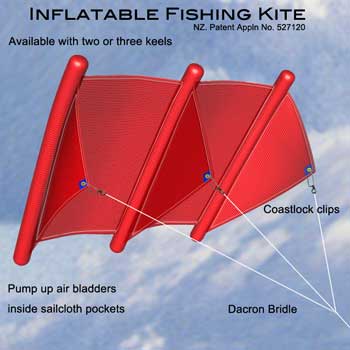 Both swivels and snap clips are too weak to hold the new inflatable kites. Both swivels and snap clips are too weak to hold the new inflatable kites.
If this is your first inflatable kite we suggest you also purchase a kite pump from Paul's Fishing Kites.
A kite pump makes the task of inflating the kites much easier and gives a more even pressure in the air bladders.
Your parcel includes:
- One Inflatable kite fitted with air bladders
- Three spare air bladders
- One pre-tied dacron bridle wound onto a corflute card
- Three deflating straws
- One coastlock clip for your kiteline
- Instructions
Inflating the Kite Manually
Make sure the bladders are fully inside the kite. If you are blowing the kite up manually, cut 50mm off each deflating straw and insert into the valve so that around 10mm is left protruding (this keeps the lip of the valve open). Then inflate as you
would a balloon.
You will notice that the non-return valve prevents the air from escaping when you stop blowing and this makes it easier to get a good pressure in the bladders.
If you blow each bladder up as hard as you can, all the bladders will have about the same
pressure. It is impossible to damage the kite if you are inflating by mouth.
If you are having trouble putting the straw in the kite, look closely and you will see that one lip of the valve is cut off lower than the other and you may be trying on the wrong side.
Cutting the straw at an angle can also help make insertion easier.
With a Kite Pump
Make sure the bladders are fully inside the kite. Contrary to logic, over-inflating the air bladders so they are drum tight and the struts completely rigid does not improve the performance of the kite, it will cause the pockets to bow, spoil the aerodynamics
of the kite and the light wind performance will be severely reduced.
The air bladders are slightly larger than the pocket on the kite as this reduces the stress on the air bladder and stops it stretching or rupturing if over inflated. All the air pressure is carried by the stitching on the kite so over-inflating the
bladder can put excessive force on the kite stitching and/or stretch the pocket.
Insert the nozzle of the pump into the valve and pump until the creases disappear from the pocket then stop and feel the pressure by squeezing the pocket between your index finger and thumb.
If the kite is at the right pressure a moderate squeeze should
be sufficient to allow the fingers to touch each other. If the pockets are starting to bow the pressure is too high and a straw should be fully inserted into the valve to let some of the air out.
|